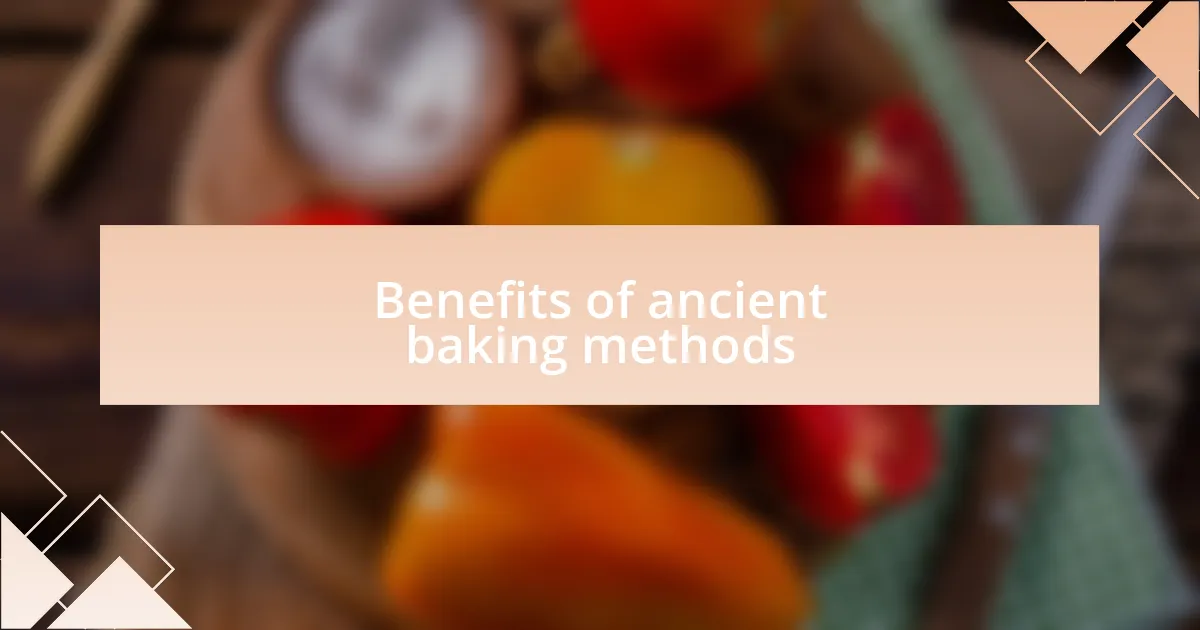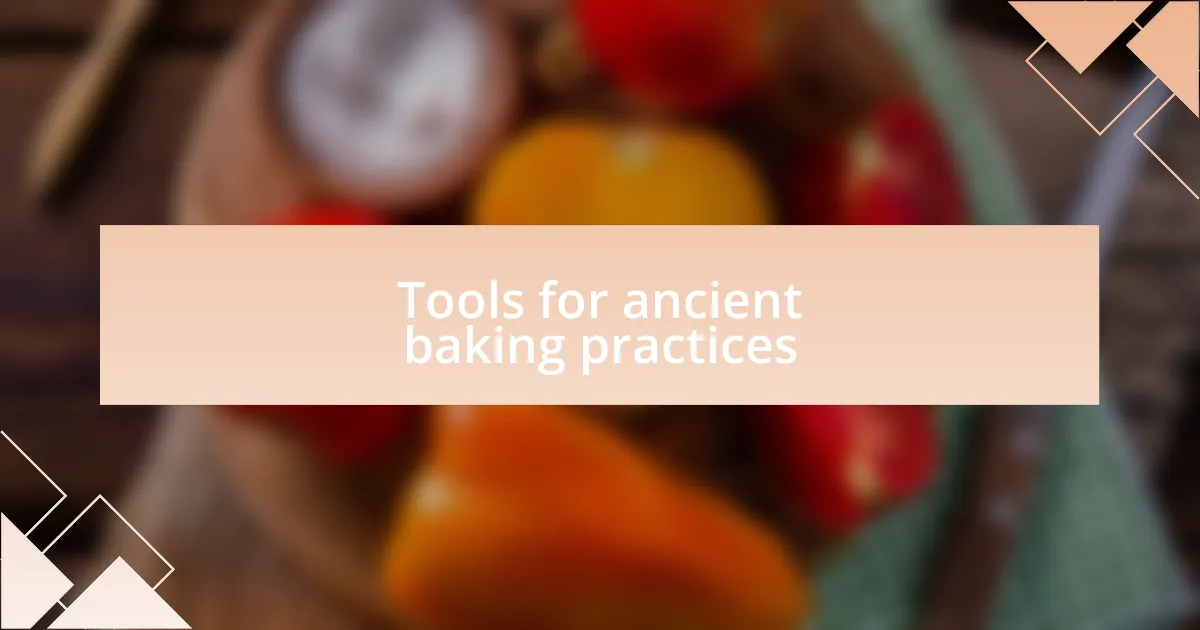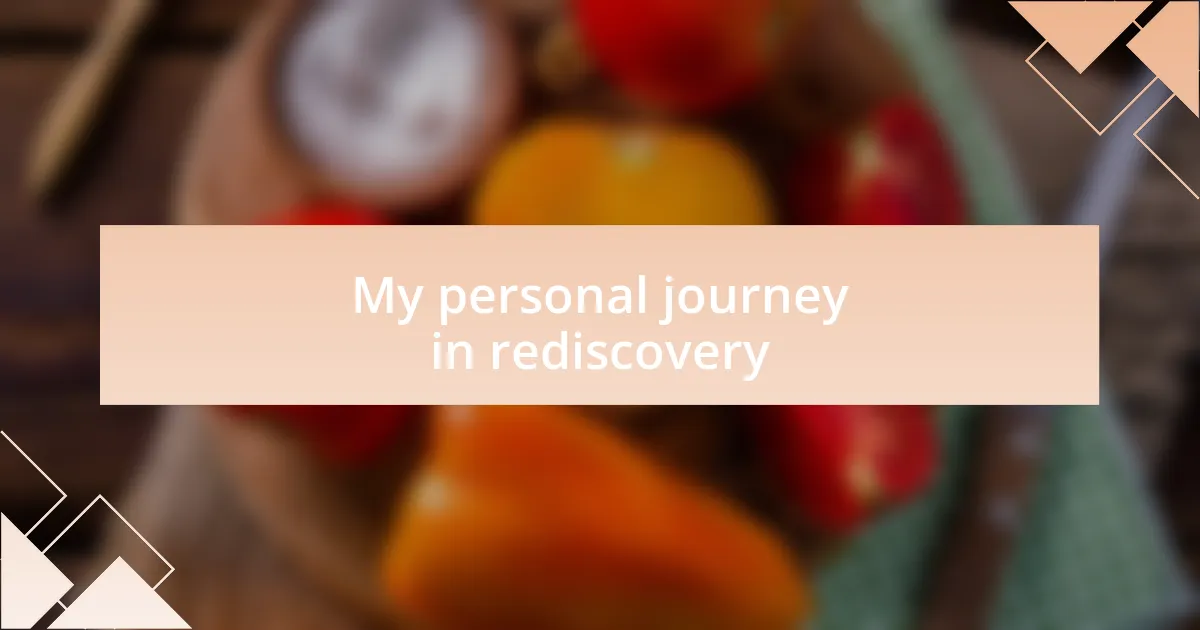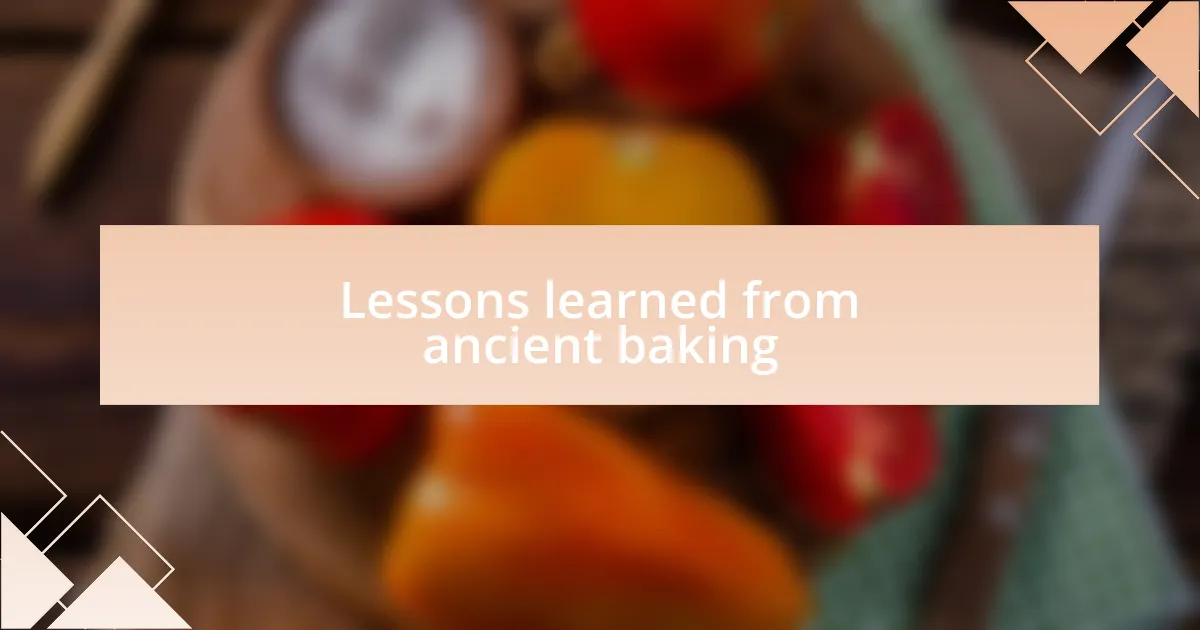Key takeaways:
- Culinary education connects traditional techniques with modern practices, highlighting the importance of understanding the past to innovate in cooking.
- Ancient baking methods enhance nutritional value, foster creativity, and promote sustainability, revealing a deep connection between food, culture, and environment.
- Tools and practices from ancient baking, such as natural leavening and stone baking, enrich the baking experience, emphasizing tactile engagement and simplicity.
- Engaging in communal baking experiences strengthens bonds and transforms the act of baking into a collaborative ritual, highlighting the social aspects of food preparation.

Culinary education overview
Culinary education is a vibrant tapestry woven from tradition, technique, and innovation. From my experience, stepping into a culinary school felt like entering a world where every ingredient tells a story and each technique is a bridge to the past. Remembering my first hands-on lesson with bread, I can’t help but wonder: how many generations before us perfected these methods?
The curriculum often spans traditional cooking techniques alongside modern approaches, creating a dynamic blend of knowledge. I was fascinated by how much ancient practices influence contemporary cuisine; it sparked a realization that these age-old methods aren’t just relics but essential tools for creative expression. Does anyone else feel that deep connection to food when they knead dough as our ancestors did?
Moreover, culinary education isn’t solely about recipes; it encompasses culture, history, and even science. I remember my instructor emphasizing the chemistry behind fermentation, which deepened my appreciation for the process. Isn’t it amazing to think that understanding the science of baking can transform our culinary creations drastically?

Importance of traditional techniques
Traditional baking techniques are essential because they connect us to our culinary heritage. I vividly recall my first attempt at sourdough. The meticulous process of nurturing a starter and watching it grow felt like an intimate conversation with bakers of the past. Isn’t it fascinating how these techniques have endured through centuries, reflecting not just skill, but also culture and community?
Preserving ancient methods also allows us to appreciate the flavors and textures that modern shortcuts often overlook. I remember biting into my first loaf made with whole grains milled fresh. The depth of flavor took me by surprise; in that moment, I understood how our ancestors valued every subtle note in their bread. Don’t you think there’s something special about using techniques that engage the senses at such a profound level?
Furthermore, embracing these traditional methods fosters creativity in our current cooking practices. For instance, I once experimented with a recipe passed down from my grandmother, adapting it to incorporate new ingredients while retaining the original technique. It was a bridge between generations, reminding me that innovation often thrives on the solid foundation of tradition. How can we truly innovate without understanding where we come from?

Benefits of ancient baking methods
Ancient baking methods carry a wealth of benefits, particularly in enhancing the nutritional value of the food we consume. When I first tried my hand at sourdough fermentation, I was astonished by how much easier my body found the digestion of this naturally leavened bread compared to commercial loaves. The long fermentation process not only developed flavor but also increased the bioavailability of nutrients—something I had never considered before. Isn’t it amazing how a technique developed centuries ago can still resonate so strongly with our modern nutritional needs?
Another profound benefit I discovered is the connection formed with the ingredients themselves. I remember milling my own flour for the first time while following an ancient grain method. The earthy aroma that filled my kitchen was intoxicating and made me appreciate the grain in a way that store-bought flour simply doesn’t offer. In a world of processed foods, don’t you think that nurturing a more genuine relationship with our ingredients can lead to a more fulfilling baking experience?
Lastly, utilizing ancient techniques encourages a more sustainable approach to baking. When I started incorporating methods like wood-fired baking, I realized how energy-efficient it could be, harnessing fire for heat instead of relying on electricity. This revelation sparked a deeper understanding of how our ancestors baked with purpose, minimizing waste and maximizing flavor. As we face modern environmental challenges, isn’t it vital for us to look back and learn from these time-tested practices?

Key ancient baking techniques
Key ancient baking techniques tap into a wealth of knowledge passed down through generations. One that stands out for me is the use of natural leavening agents, such as wild yeast and sourdough starters. The first time I cultivated my own starter, I felt like a true alchemist, watching the mixture bubble and flourish. It was thrilling to realize I was using the same technique that bakers relied on centuries ago. Have you ever felt that connection with a simple mixture of water and flour?
Another intriguing technique is the practice of baking with ancient grains like spelt and einkorn. I remember the first bread I made with spelt flour; it had this incredible nutty flavor and dense texture that was utterly satisfying. This grain, known for its digestibility and complex nutrients, reminded me of how diverse and rich our food history is. Don’t you sometimes wish we could preserve these flavors and stories in our modern diets?
Lastly, the art of stone baking truly resonated with me when I experimented with a homemade clay oven. The way the heat distributed evenly thanks to the stone was a revelation. Baking in that oven felt like stepping into another era, where every loaf was crafted with care. What if we could all find joy and connection in such a simple yet transformative process?

Tools for ancient baking practices
Tools for ancient baking practices often have their own stories to tell. For instance, when I stumbled upon a wooden dough bowl at a local flea market, I felt an instant connection. It was an object that had likely seen countless batches of bread, imbued with the history of generations kneading and shaping their doughs. Have you ever held something that felt like a portal to the past?
Another essential tool that captures the essence of ancient baking is the stone mill. I had the chance to grind my own flour using a hand-cranked stone mill, and the experience was enlightening. As I turned the crank, the aroma of freshly milled grains filled the air, and I couldn’t help but feel the profound simplicity of this method. What’s more satisfying than knowing the flour I used was as fresh as it could be?
Finally, let’s not overlook the significance of a baking peel, especially when I first used one to transfer my bread into the oven. It felt like an ancient ritual, akin to a baker’s dance. The delight I experienced as my loaf slid smoothly onto the hot stone was exhilarating. How often do we miss the joy of such tactile interactions in our fast-paced culinary world?

My personal journey in rediscovery
As I wandered through an old bookstore, I discovered a dusty cookbook filled with ancient baking techniques. Flipping through its yellowed pages felt like unearthing a treasure trove of culinary wisdom. I vividly recall the moment I came across a simple recipe for flatbreads, which ignited a spark of curiosity in me—what stories lay behind these age-old practices?
One evening, driven by a yearning to connect with the past, I decided to try one of those recipes. I gathered all the ingredients and, as I mixed the dough with my hands, I could almost sense the generations of bakers who had come before me. Scraping the sticky mixture from my fingers, I realized that this tactile engagement brought me much closer to the roots of baking than simply watching a video tutorial ever could.
While experimenting with sourdough, I often found myself reflecting on the concept of time in baking—how ancient methods rely heavily on patience. Kneading the dough felt meditative; I pondered the idea that my modern convenience-driven approach was often at odds with this timeless practice. Isn’t it interesting how taking a step back can redefine our culinary experiences?

Lessons learned from ancient baking
Engaging with ancient baking techniques taught me the profound importance of simplicity in the culinary arts. I remember the first time I tried my hand at using only flour, water, and salt to create a rustic loaf. It struck me how these basic ingredients could transform into something nourishing and delicious, reminding me that culinary excellence often lies in mastering the fundamentals rather than relying on extravagant additions.
Another lesson emerged through experimenting with natural leavening. I found it fascinating how early bakers often relied on wild yeast and fermentation processes. One evening, I delighted in the gentle bubbling of my sourdough starter, watching it come to life. This connection to nature made me realize that baking is not just a science; it’s an art intertwined with the environment. How often do we pause to appreciate the invisible forces at play in our kitchens?
Moreover, I discovered that the communal aspects of ancient baking are just as vital as the techniques. While preparing dough one Saturday afternoon, I invited friends to join in the process. As we laughed, kneaded, and shared stories, I felt a sense of belonging that transcended the act of baking. Could it be that the rituals of making bread were not only about the food itself but also about the bonds we strengthen through shared experiences?